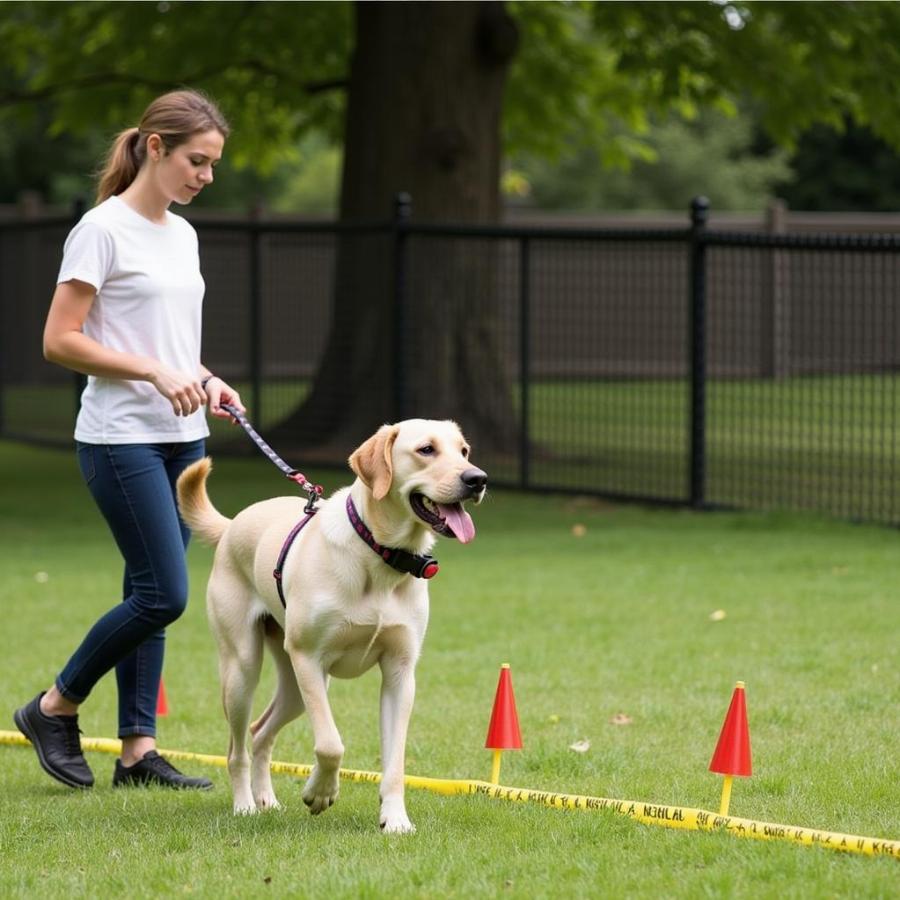Dog e fences, also known as invisible fences, offer a convenient and cost-effective way to contain your furry friend within a designated area without the need for a traditional physical fence. They provide a safe and reliable boundary, giving your dog the freedom to roam while ensuring they stay within your property lines. Understanding the various types of dog e fences, their pros and cons, and how to choose the best one for your dog’s breed and temperament is crucial for a positive experience.
Understanding Dog e Fence Systems
Dog e fences work by creating a wireless boundary using radio signals. A transmitter plugged into a standard outlet sends a radio signal to a wire buried underground or a central unit for wireless systems. Your dog wears a receiver collar that beeps when they approach the boundary. If they continue further, they receive a mild static correction. This system trains your dog to associate the beeping with the boundary, teaching them to stay within the designated area.
Types of Dog e Fences
There are two main types of dog e fences: wired and wireless.
Wired Dog e Fences
Wired systems require burying a wire underground to define the boundary. They offer greater flexibility in terms of shape and size and are generally more reliable, especially for larger properties.
Wireless Dog e Fences
Wireless systems create a circular boundary around a central unit. They are easier to install and more portable, making them a good option for renters or those who frequently move. However, they are less customizable and may be affected by metal objects or interference from other electronic devices.
Factors to Consider When Choosing a Dog e Fence
Several factors should be considered when choosing a dog e fence:
- Your Dog’s Temperament and Size: For stubborn or larger breeds, you may need a system with a stronger correction level. Conversely, for timid or smaller dogs, a gentler setting is recommended.
- Property Size and Shape: Wired systems are better suited for larger or irregularly shaped properties, while wireless systems work well for smaller, circular areas.
- Installation and Portability: Wireless systems are easier to install and more portable, while wired systems require more effort but offer more customization.
- Features: Some systems offer features like adjustable correction levels, multiple dog capability, and tone-only mode for training.
- Budget: Prices vary depending on the type of system, features, and brand.
Training Your Dog with an E-Fence
Proper training is essential for the effectiveness of a dog e fence. Start by introducing your dog to the boundary flags that mark the perimeter. Walk your dog around the boundary, allowing them to hear the warning beeps. Gradually introduce the static correction, ensuring it is not too strong for your dog. Consistency and positive reinforcement are key to successful training.
 Dog Training with an E-Fence
Dog Training with an E-Fence
Common Questions About Dog e Fences
How do I find a break in my invisible fence?
There are specialized tools and techniques for locating breaks in a wired dog e fence, including using a radio receiver or a continuity tester. You can also consult the manufacturer’s instructions or contact a professional for assistance. More details can be found in our guide on how to find a break in an invisible dog fence.
Are dog e fences safe?
Yes, dog e fences are generally safe when used correctly and with proper training. The static correction is mild and designed to deter, not harm, your dog.
What is the best wireless dog fence?
The “best” wireless dog fence depends on individual needs and preferences. Consider factors like range, battery life, and features when choosing a system. Our guide on the best wireless dog fence can help you make an informed decision.
Can I use chicken wire with a dog e fence?
While you can combine a physical barrier like dog fence with chicken wire with an e-fence, it’s generally not necessary. The e-fence acts as the primary containment system.
Conclusion
Dog e fences are a valuable tool for pet owners seeking a convenient and effective way to contain their dogs. By understanding the different types of systems, considering your dog’s specific needs, and implementing proper training techniques, you can create a safe and enjoyable environment for your furry friend. Remember, selecting the right dog e fence requires careful consideration and research.
FAQ
- Are dog e fences cruel? No, when used correctly, the static correction is mild and acts as a deterrent, not a punishment.
- Can I use an e-fence with multiple dogs? Yes, many systems offer the capability to add multiple collars.
- How much does a dog e fence cost? Prices vary depending on the type, features, and brand.
- How long does it take to train a dog with an e-fence? Training time varies, but consistency is key.
- What happens if the power goes out? Most systems have battery backup.
- Can a dog e fence be used on any terrain? Yes, but certain terrains may require adjustments to the system.
- Are there any alternatives to dog e fences? Yes, traditional fences, tie-outs, and GPS invisible fence for dogs are alternatives.
Looking for more information on dog fences? Check out our article on no dig dog fence.
Beaut Dogs is your trusted source for all things dog-related, providing reliable, helpful, and in-depth information about the canine world. From breed characteristics and care needs to training tips and product recommendations, Beaut Dogs helps you navigate the joys and responsibilities of dog ownership. When you need assistance, contact us at [email protected] for detailed and accurate answers from Beaut Dogs.